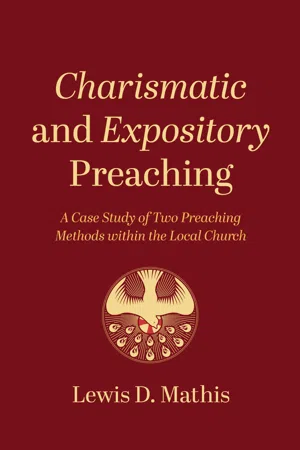![]()
Chapter 1: Introduction
Introduction
Expository preaching has been the foundational tool for centuries within the church in conveying the word of God to its congregants. However, the emerging charismatic movement and its preaching have caused great concern regarding the fundamentals of the Bible’s expository preaching. Considering this movement, charismatic preachers see tremendous growth in their ministries. In many local churches, pastors who hold steadfastly to expository preaching are experiencing a considerable decline in their churches.
Therefore, the need for this research is relevant to studying these methods of preaching to determine if they can coexist as a firm preaching method. Thus, charismatic preaching has great potential for being incorporated into some mode of expository preaching that is biblically sound and creates church growth. This study will help New Hope Missionary Baptist Church tremendously, considering that formerly, the church was charismatic under the church’s previous pastor.
The research project aims to conduct a case study of two preaching methods by exploring the charismatic movement’s humble beginnings originating from the Azusa Street Revival and by understanding the fundamentals of expository preaching. Today, “[the] Charismatic movement has been transformed into the fastest-growing segment of Christianity in America and throughout much of the world.” According to Mohler, “some experts estimate that the movement includes almost a half-billion adherents worldwide.” This movement has incorporated traditional Pentecostals, the Assemblies of God, and strong influences in Southern Baptist churches. Although Mohler’s article is dated in the year 2000, the statistics provided are relevant in showing how effective the charismatic movement was and how it has changed the church. However, concerning expository preaching, James F. Stitzinger has said, “Historical study of expository preaching begins with a proper understanding of the record of preaching in Scripture. Preaching in the Bible is in two basic forms: revelatory preaching and explanatory preaching.” These terms will be defined later within the contents of this research.
All postbiblical preaching has the backdrop of the preaching recorded in Scripture and must trace its roots to this source. The Bible is the source of preaching; charismatics and expository preachers must draw from that source. That being the case, why is there a decline in local churches firmly rooted in expository preaching but an increase in charismatic churches? Therefore, the study is relevant in understanding why Christians are gravitating toward charismatic preaching and worship instead of expository-based preaching and worship. Visiting charismatic and expository-based churches, seeing how worship services flow, interviewing the pastors and chairpersons of the deacon board, getting questionnaires answered by congregants, and doing biblical research will be a starting point to answering this question.
Most local churches have pastors that are firm in expository preaching. They are preaching the word of God with clarity, and excellent hermeneutical skills are paramount in revealing the author’s original intent to their congregants, not adding or taking away from the passage to fit their needs or justify their actions. Nonetheless, with this sound doctrine preached from an informative-based method, these churches experience no growth. Only the faithful few stay. Therefore, how could this be? When expository preaching illuminates the Scriptures, it clarifies God’s word for those in attendance. Merrill F. Unger, being an advocate for expository preaching, asserts:
Unger argues for results from their preaching. People, by the Holy Spirit’s movement, should gravitate or be drawn to the message, becoming a part of that assembly/church and causing growth. However, the charismatic approach and its preaching acknowledges Scripture (God’s word) as authoritative in concert with expository preaching. The charismatic asserts more emphasis on the Holy Spirit’s movement, or baptism in the Spirit, by evidence of speaking in tongues (glossolalia) and the work it was sent to do (gifts of the Holy Spirit) in empowering Christ’s church. Expository preachers hold to the centrality of Sola scriptura as foundational to sound preaching while not denying the Holy Spirit’s works and the hermeneutics of charismatics concerning pneumatology and spiritual experience. Unger’s article, although dated 1954, is essential in understanding the very foundation of expository preaching in this modern era.
Charismatics’ understanding of the Holy Spirit is the dividing factor between these two preaching methods. Charismatics believe the empowering of the Holy Spirit is a subsequent event in the conversion of the believer. In other words, Charismatics believe there is a baptism of the Spirit as a “second blessing” or experience that occurs after salvation. They also think that a believer must possess spiritual gifts, such as healing with the laying on of hands and especially speaking in tongues, as evidence of their conversion into the body of Christ.
Although there is a significant concern from a hermeneutical perspective concerning this argument, one cannot overlook the charismatic doctrine’s effectiveness, which has generated tremendous growth in the church. The charismatic movement cannot be ignored from a biblical perspective because of its foundational recognition of Scripture being authoritative; thus, the fact that it stands on God’s word, with spiritual charisma provided by the Holy Spirit, institutes merit for this method of preaching. Therefore, it is the purpose of this research to find common ground between these two preaching methods and determine if they can coexist as one sound doctrine from a biblical perspective for the growth and empowerment of Christ’s church.
Ministry Context
This research will benefit New Hope Missionary Baptist Church (NHMBC) and other small local churches. However, being a member of New Hope for nineteen years, I have observed tremendous growth and decline of the church throughout the years. The former pastor, who without a doubt was tremendously charismatic in his preaching style, influenced many people to know Christ and...
